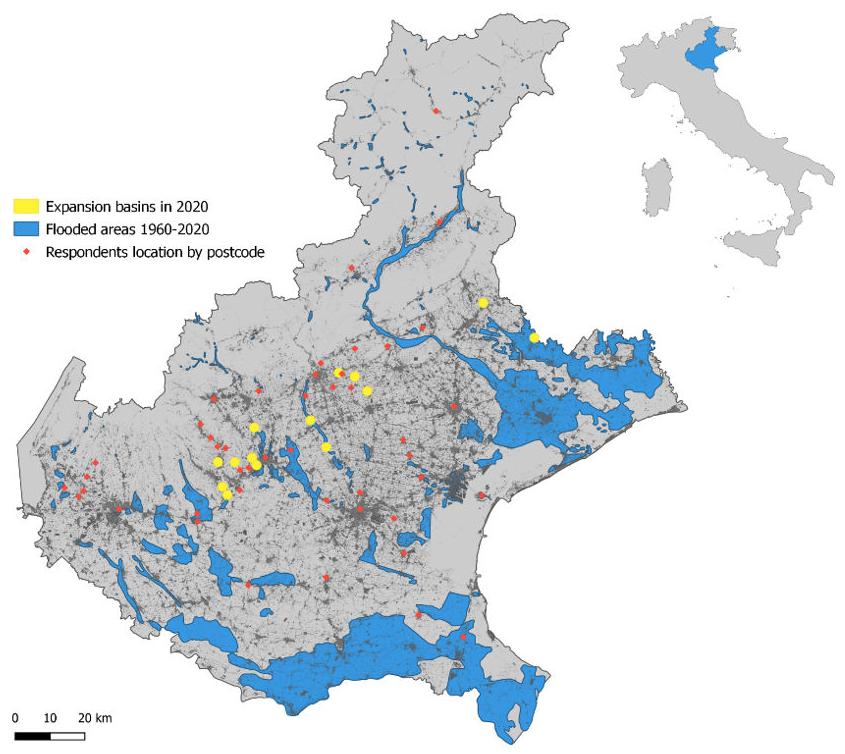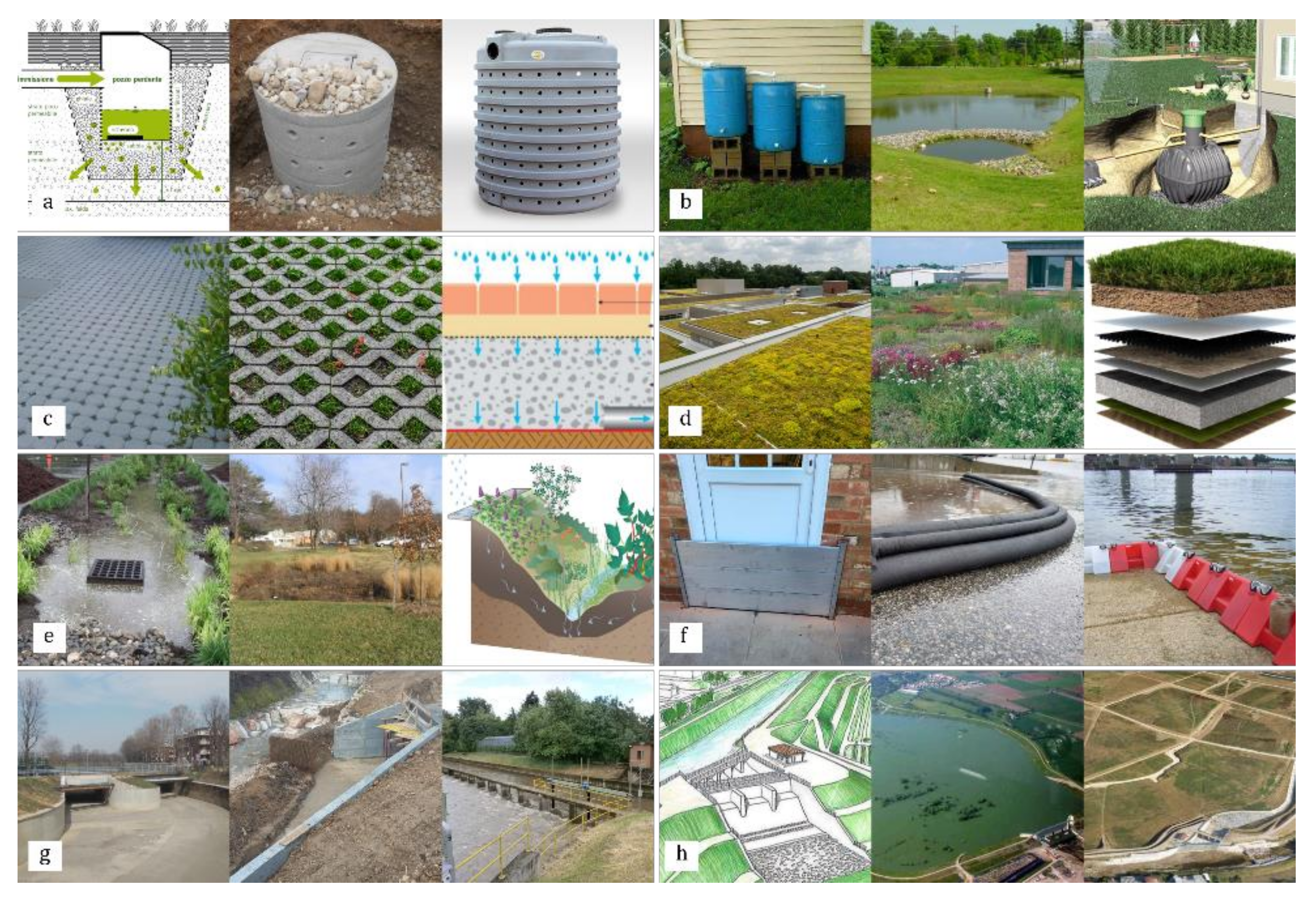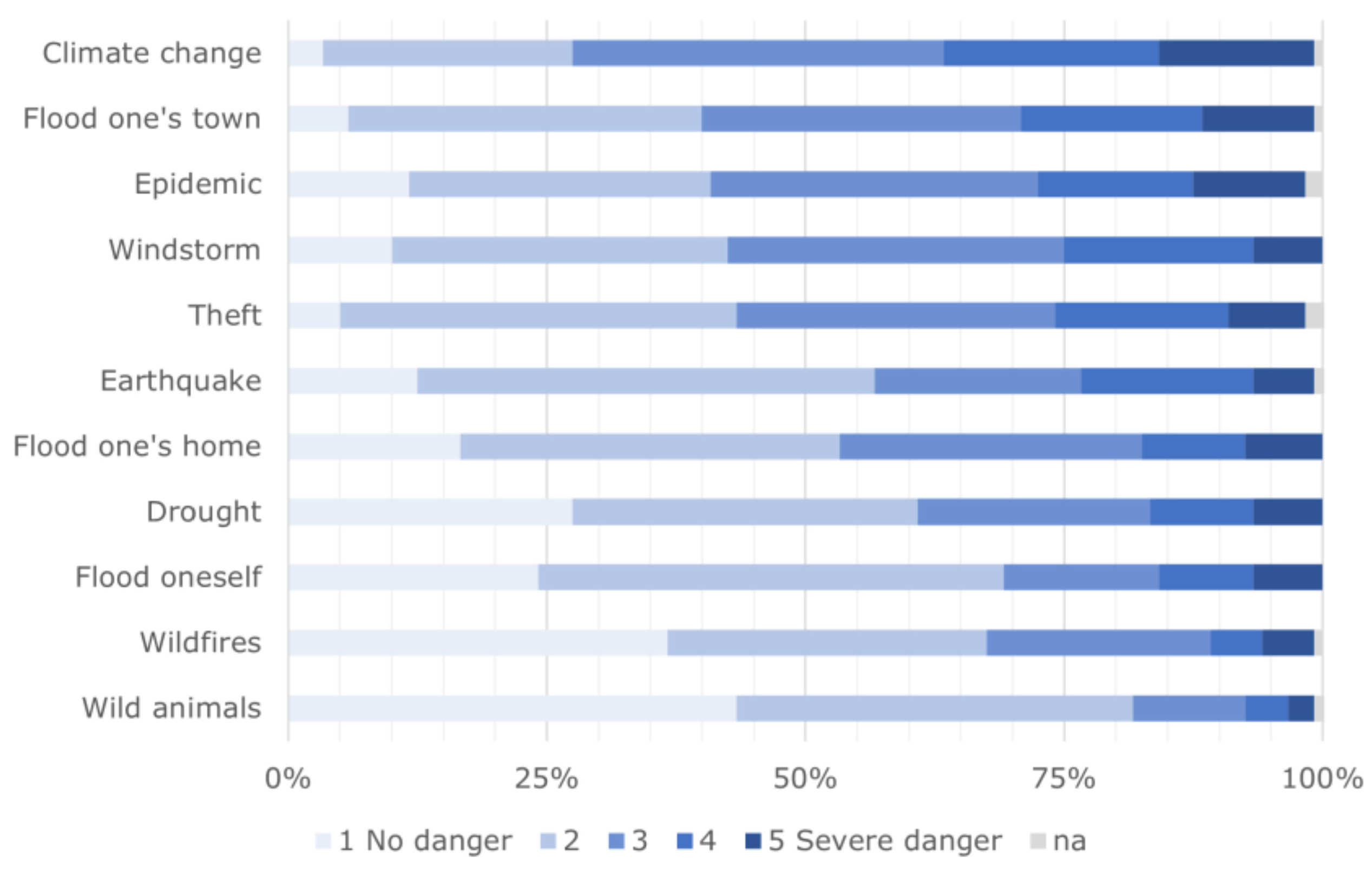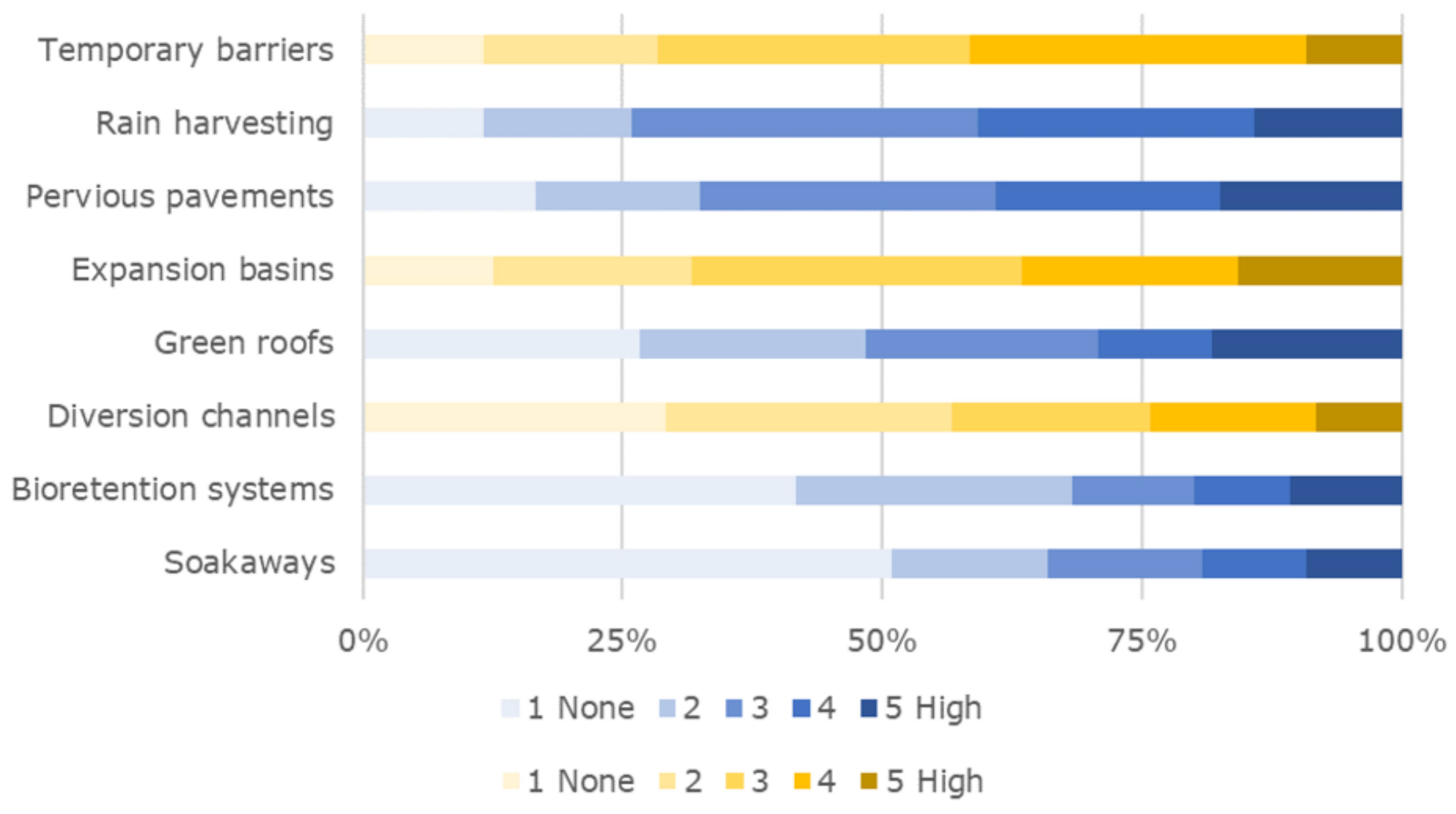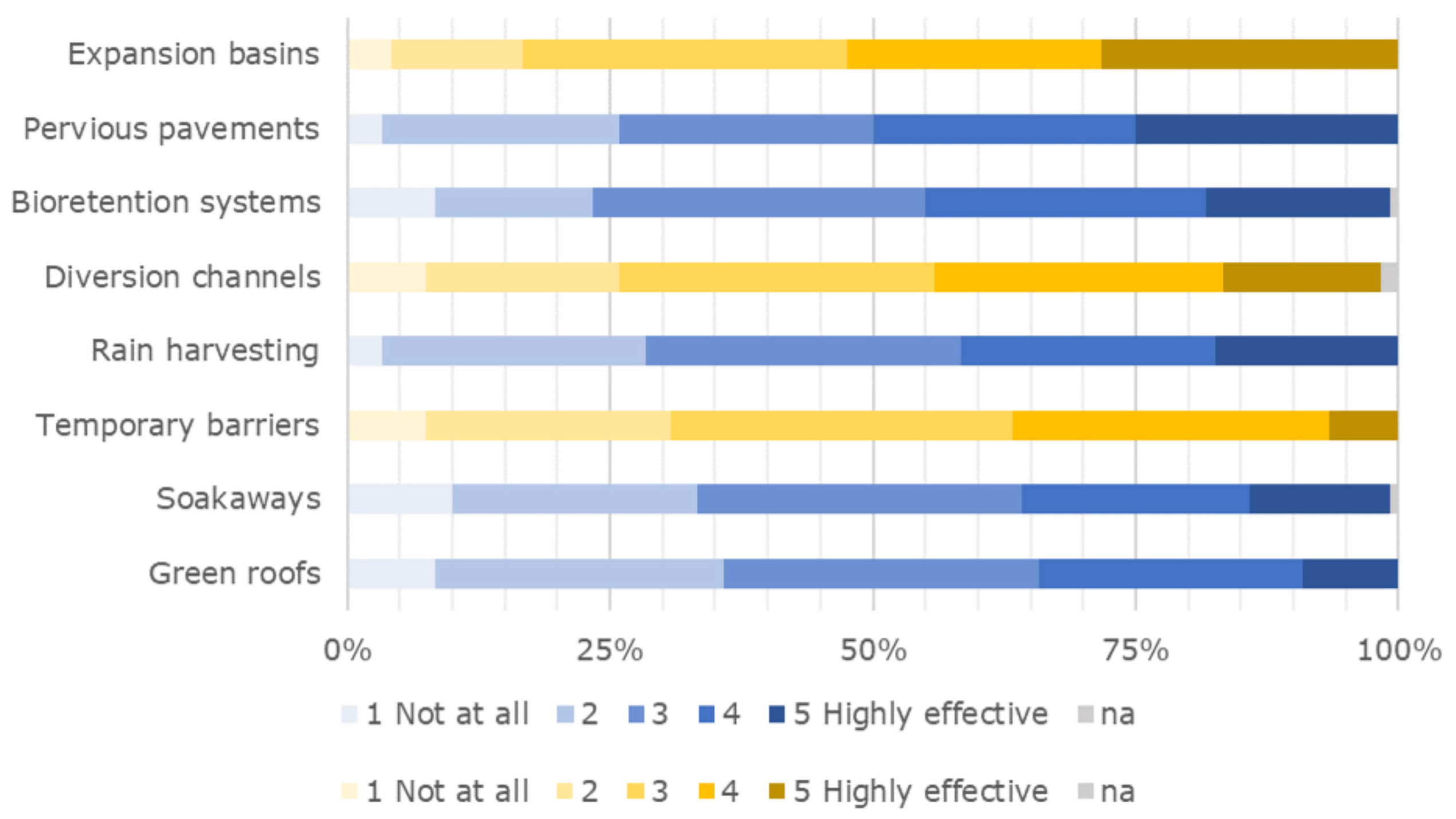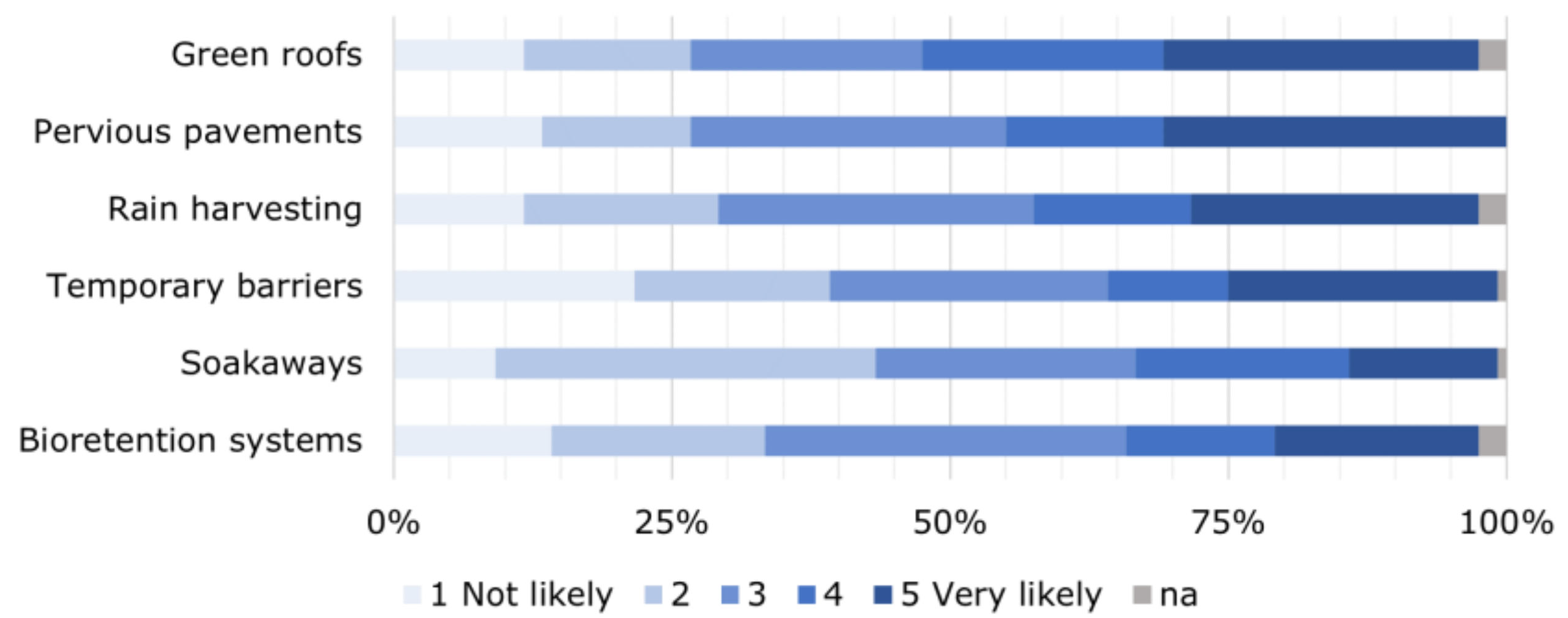1. Introduction
Flooding from rainfall has become more frequent due to a growing number of extreme rainfall events related to climate change [
1,
2,
3] as well as increasing urbanization. Half of the world’s population already lives in urban areas, and projections suggest that this share will increase to 66% by 2050 [
4]. Thus, there is an impelling need for solutions that tackle flood risk and, at the same time, increase human wellbeing in urban environments [
5]. Nature-based Solutions (NBS) have been put forward as an efficient and cost-effective way to cope with an increase in flood risk and urbanization [
6]. NBS have emerged as multifunctional infrastructures that can contribute to increased urban resilience with numerous benefits for both people and the environment. As green spaces, NBS can mitigate urban heat island, air and water pollution, and have great potential to increase human well-being and reduce stress [
7]. NBS can be implemented alone or in combination to maximize their benefits. For example, a domestic water management system could be structured with a green roof followed by some rain barrels, and the excess water could be drained into a soakaway.
Nevertheless, NBS are not yet widely implemented around the world [
8], especially in urban areas [
9]. This may be due to a lack of knowledge about and confidence in NBS on behalf both of people, who do not want to invest in something they do not know, and of policy makers, who should promote the adoption of NBS to provide more sustainable and resilient cities for their citizens [
10]. Understanding people’s perceptions and knowledge of NBS is thus a first step in effectively promoting their use [
5,
11,
12,
13]
Over recent decades, the management of urban rainfall has become more complex, with the development of many new approaches and systems [
14,
15]. Urban drainage systems are commonly divided into “grey” and “blue-green” infrastructures. Grey infrastructures include all the conventional engineering systems that have the sole aim of reducing flooding (e.g., diversion channels, drainage pipes, large storage tanks). Green-blue infrastructures, on the other hand, comprise multipurpose systems to control the quantity of runoff, manage the quality of the runoff to prevent pollution and create and sustain better places for people and nature [
14,
16]. While grey infrastructures move runoff from one place to another with the sole aim of diverting water away from cities, green-blue infrastructures control runoff by attenuating the discharge peak. This can be achieved by slowing, storing and infiltrating into the soil runoff directly where it falls. Besides, many of these green-blue systems also use vegetation to enhance their ecological value, mitigating heat and air pollution and improving urban ecosystems with new habitats for wild animals and plants.
Over the years, many green-blue drainage systems have been developed all over the world, each one with its own denomination that describes the system’s functionality. Consequently, a whole new area of terminology has been developed, but mainly in an informal manner. As found by Ellis et al. in the Urban Drainage Multilingual Glossary [
17], this informal and mainly local evolution led to a lack of professional terminology, which is useful to convey ideas, concepts, methods and techniques. After that, Fletcher et al. [
18] sought to document the recent history and evolution around urban drainage systems terminology with the aim of drawing out the important principles, processes and objectives that drive this evolving practice. The main terms currently used to refer to urban drainage systems that include a sustainable approach are green infrastructures (GI), Sustainable Drainage Systems (SDS), Sustainable Urban Drainage Systems (SUDS) and Nature-based Solutions (NBS).
GI were initially identified in the USA in the 1990s for their potential ecosystem services and promoted as a network of green spaces to implement in urban planning [
18]. In the same period, in the UK, the concerted approach to stormwater management that was begun in the 1980s led to new guidelines that include a range of technical runoff control options.
Besides GI and SDS, the European Commission uses the term Natural Water Retention Measures (NWRMs) to identify adaptation measures that use nature to regulate the flow and the transport of water to smooth the discharge peak and moderate extreme events [
19].
Therefore, while GI seem to be described mainly as vegetated urban elements, and SDS mainly refer to urban drainage systems with and without vegetation, NWRMs consider all possible applications, from direct ecosystem modifications (e.g., ponds, wetlands, river and aquifer restoration) to all the adaptations in land-use and water management practices in agriculture (e.g., meadows, buffer strips), forestry and pastures (e.g., riparian buffers, urban forests), and urban environment (e.g., green roofs, rainwater harvesting, rain gardens).
Nature-based Solutions (NBS) is another widespread term that defines a set of alternative solutions that conserve, manage in a sustainable way and preserve the functionality of natural ecosystems, or restore functionality in ecosystems altered by humans, in order to increase human well-being and biodiversity and food and water security, as well as to mitigate the risks of disasters and social and economic development [
20]. The International Union for Conservation of Nature (IUCN) defines NBS as “
actions to protect, sustainably manage and restore natural or modified ecosystems that address societal challenges effectively and adaptively, simultaneously providing human well-being and biodiversity benefits”.
The European Union is also investing in NBS, with EU Horizon projects to achieve several goals, namely job creation, economic growth and innovation, while tackling global environmental challenges for a long-term economic competitiveness and security [
21]. Because the term NBS is now widely used within the EU and by EU institutions, in this paper we will refer to these systems as Nature-Based Solutions (NBS).
Since the approach to NBS implementation is based on the in-situ management of rainfall, the best place to install them is where runoff originates. In an urban environment, this means that NBS must be installed near buildings and impervious surfaces, and most of them will be in or near private properties. Thus, if NBS are not perceived as useful or cost-effective, their implementation may be hindered. According to previous studies, residents’ self-protective behaviors in flood-prone urban areas can reduce monetary damage by 80% [
22]. However, the lack of knowledge and confidence in NBS may result in residents not implementing them [
23,
24,
25]. Understanding people’s attitude toward NBS is also useful to help policymakers improve urban planning by promoting their adoption [
26,
27,
28].Williams et al. [
29] found that people have varied levels of awareness of the presence and multifunction of NBS, and in South Australia, Sharma et al. [
25] found that the water conservation and flood mitigation of NBS are well recognized by residents. Baptiste et al. [
24] found that there is a strong willingness to implement green infrastructures, if they are provided free of charge and if savings are achieved with their implementation. Other studies also explored NBS implementation through people’s willingness to pay to adopt them [
9,
28] and found that, despite a general low knowledge of NBS, their adoption is supported by residents.
Indeed, the issue of increased urbanization and urban flooding is particularly relevant in Italy, where up to 7% of the national territory is covered by artificial land (21,398 km
2, as of 2019) [
30,
31,
32].
While previous studies mainly focused on a single city experience, this work aims to explore the attitudes towards NBS on a wider scale and to characterize people’s perception of and willingness to implement NBS in Veneto, a region of north-Eastern Italy.
2. Materials and Methods
People’s perceptions of NBS were investigated through a questionnaire survey in the Veneto region, in north-eastern Italy. The region has about 4.9 million inhabitants [
33]. The territory is quite heterogeneous, ranging from floodplains (56.4%) to hills (14.5%) and mountains (29.1%). The plains’ climate is characterized by continental conditions with an average temperature of 13–15 °C, cold and dry winters and hot summers, while the Alpine area climate is cooler, rain is well distributed over the year and the weather is strongly conditioned by the local morphology. The annual rainfall varies between 600 and 1100 mm [
34]. Veneto is the second Italian Region for land consumption, with 2176 km
2 of urban areas in 2019 (11.9% of the total regional area) [
30]. According to ISPRA [
35], 25.2% of the regional area is at risk of flooding and 9.5% of Veneto’s residents live in a flood-prone area (
Figure 1). This land and climatic variability, combined with the high flood risk and the increasing urbanization of the region, represents a good opportunity to investigate the perception of and the attitudes towards NBS among Veneto’s population.
2.1. NBS and Grey Infrastructures Evaluated in This Study
The survey focused on five NBS: soakaways, rain harvesting, permeable pavements, green roofs and bioretention systems. These were chosen because they could be more successfully implemented in urban areas or could have an impact on urban areas.
To shed light on potential different perceptions, three grey water management systems are also taken into account: temporary flood defense barriers, expansion basins and diversion channels. These grey infrastructures are already implemented in the study area, which means that people may already know them and could compare them with the less widespread NBS.
To introduce the evaluated water management systems, a short description of them was presented to the respondents, as well as a few explanatory pictures, as shown in
Figure 2.
2.2. Data Collection
The survey was administered online through Google Modules. The link to the survey was initially shared via e-mail and social networks. People were also asked to share the link themselves with their network. Considering the explorative nature of the study, participants were recruited through convenience sampling [
36,
37]. Due to the pandemic caused by the Sars-COV-2 virus in 2020 and the consequent limitations imposed by the governmental response in Italy, this method was deemed the most suitable to reach as many people as possible in the available timeframe. Before accessing the survey, respondents were informed about the aim of the research project and personal data processing. People that agreed with the conditions were then redirected to the survey form.
A total of 120 respondents filled in the survey. Of these, 70.8% of respondents lived in urban or suburban areas, and 61.7% have lived in the same house for more than 20 years. Almost half (48%) of the respondents lived in an independent house, 29% in a small building (max four household) and the remaining 23% lived in an apartment block (more than 4 households). In addition, 88% of respondents owned their house, while the remaining 12% lived in a rented home.
Compared to the available census data, the distribution of the sample is quite representative of the overall population in terms of gender, though women were slightly overrepresented in the sample (57%, compared to 51%). As expected, and because the survey was initially shared through social media and university channels, the sample is slightly younger than the local population, with 51% of the respondents younger than 30 years old. 5% of respondents live in a municipality flooded during the time 1960–2020.
2.3. Survey Design
The survey was structured in six sections:
Territorial features: people were asked where they live and for how many years they have lived there.
General risk perception: different potentially dangerous events were proposed (e.g., earthquake, climate change, wild animals, epidemic, theft, flood, drought, windstorm, wildfires), and people had to express their risk perception on a Likert scale from 1 (no danger) to 5 (severe danger).
Water management systems knowledge: the drainage systems proposed were briefly described, and some explicative pictures were shown. For every design, people were asked if they knew the system before the survey.
Perception of efficacy and willingness to implement: in this section people were asked to evaluate the perceived efficacy of the drainage systems and at what scale they think every system should be implemented. Respondents were also presented with a contingent valuation with a dichotomic choice for a bioretention house-scale implementation project.
Connection with the territory: respondents were presented with statements on which persons/entities should be trusted with flood risk management, personal trust in the local community, the level of knowledge of the presence of NBS in the territory, the willingness to implement NBS in their properties, etc., to which they had to express their level of agreement on a scale from 1 (completely disagree) to 5 (completely agree).
Socio-demographic variables: age, gender, educational level and current occupation.
The survey was developed to be understood and filled by people that may not be knowledgeable about NBS, so a pre-test with 15 people was conducted before the official data collection. The final survey was accessible online between October 2020 and March 2021.
Table 1 reports the main variables used in this study, as well as related questions and available answers. The full questionnaire survey (in English) can be found in the
Supplementary Materials.
2.4. Data Analysis
Data were analysed using R 3.6.3 statistical software [
38], and the responses were investigated using ordinal logistic regression (95% confidence interval).
Descriptive parameters (i.e., previous knowledge of water management systems, willingness to adopt NBS, scale implementation perception of water management systems and incentives to implement NBS) were summarized in graphs for a simpler visualization and used as a first exploration of the sample. Collected qualitative responses were used to better characterize the result of the ordinal logistic regressions. Since the qualitative answers were not so many and were very similar to each other, they were manually summarized to illustrate the main thoughts of participants.
Before assessing respondent’s perception of NBS for flood risk mitigation, we investigated their perception of flood risk. This step was fundamental because a lack of flood risk awareness may result in perceiving NBS as unnecessary or cost-ineffective.
2.5. Limitations
While the methods were selected to answer the research question in the most appropriate manner, some limitations remain. The sample size is rather small and convenience sampling could not provide an adequate representation of the region. Considering the explorative purpose of this work and the restriction due to the COVID-19 emergency, these limitations were accounted for, and the survey was developed to minimize misunderstanding surrounding the questions. Data analysis considered these limitations and focused on variables that could be less influenced by the sample distribution (e.g., age, occupation of respondents). Open-ended questions were not required to complete the survey. Despite the possibility of receiving few responses, this choice was made to avoid people leaving the survey without filling it completely.
3. Results and Discussion
3.1. Risk Perception
Respondents generally felt safe living in their communities (61% replied 4 or above on the 1-low safety to 5-high safety scale). Concerning the list of threats presented, respondents were most concerned about climate change (36% replied 4 or above on the 1, min to 5, max scale), followed by flood threats to one’s town (28%), epidemics (26%), windstorms (25%) and thefts (24%) (
Figure 3). The high perception of climate change was also confirmed in section V of the survey, where 88% of the respondents completely agreed with the statement “
climate change is a serious challenge that needs to be addressed as soon as possible”. In addition, 23% of respondents reported having a degree related to environmental and natural science, and 12.5% respondents were current students in environmental or natural disciplines.
Considering flood risk, respondents revealed an optimistic bias also detected in previous studies [
39,
40]: they seem to be more worried when they think about their community compared to when they think about themselves or their home (
Figure 3). Despite the difference in the type of hazard, the perceived flood risk in one’s town is only a little higher than the potential danger caused by an epidemic (28% vs. 26% responses with a 4 or higher score), but lower when compared with climate change perception.
3.2. Previous Knowledge of NBS and Grey Infrastructures
Respondents reported variable levels of previous knowledge about the proposed water management systems (
Figure 4). Temporary barriers were the most well-known (42% replied 4 or above on the 1, min to 5, max scale), followed by rain harvesting systems (41%), pervious pavements (39%), expansion basins (37%), green roofs (29%), diversion channels (24%), bioretention systems (20%) and soakaways (19%).
3.3. Perceived Efficacy of NBS and Grey Infrastructures
Following the self-assessment of previous knowledge about NBS and grey infrastructures, respondents were asked to express the efficacy of the proposed systems as they perceived it on a scale from 1 (not at all) to 5 (highly effective,
Figure 5). The results show only a slight difference between the perceived efficacy of grey infrastructure and NBS. Expansion basins were perceived as most effective (53% replied 4 or above on the 1, min to 5, max scale), closely followed by pervious pavements (50%), bioretention systems (44%), diversion channels (43%), rain harvesting systems (42%), temporary barriers (37%), soakaways (35%) and green roofs (34%).
Expansion basins were considered effective by many respondents, as 21% of those who provided motivations for their answer (43% of the total responses) stated that expansion basins “can collect the excess water from a watercourse and so avoid flood”. A few respondents also stated that “expansion basins are more useful to prevent floods to the downstream towns from the basin location”. These statements highlight that people may recognise that flood risk is caused mainly by flooding from watercourses and not so much by heavy rainfall or heavy urbanization. Pervious pavements were identified by a few respondents as a good substitute for hard and non-permeable surfaces in the urban environment to allow water to be absorbed in the ground, thus reducing flooding from rainfall-runoff. Perceived efficacy of bioretention systems was also high (44% with a score of 4 or higher), and environmental benefits were the main stated reason in favour of these systems. In addition, regarding bioretention systems, a few respondents stated that they would be more efficient if combined with other NBS. Similar to bioretention systems, diversion channels received 43% of the responses with a score of 4 or higher, and the main driver to their effectiveness was their potential to reduce flood risk in watercourses if they are kept in good conditions with ordinary maintenance. The general perception of rain harvesting efficacy was quite high (42% of 4 or more score). The main reason stated by people in favour of rain harvesting systems was the chance to not waste and reuse water (e.g., garden irrigation), while the one against rain harvesting was the idea that these systems could have limited efficacy due to the low volumes that they can usually store. The efficacy of temporary barriers seemed to be more related to previous flood experience. On the side of high perceived efficacy, there was the chance to avoid water entering one’s home; someone reported personal experience in the successful usage of temporary barriers during flood events. On the other side (low perceived efficacy), there was the uselessness of temporary barriers in one’s living area because respondents thought that they did not live in a flood-prone area and that the rainwater should be managed upstream from towns. Someone reported low effectiveness for temporary barriers because of personal experience with flash floods with a high-water level, in which temporary barriers would not be enough to reduce damages. Respondents’ main reasons for the low perceived efficacy of soakaways were low permeable soil and surface aquifers that do not allow water to infiltrate into the ground and some concerns about the hydrogeological risk that were mentioned previously. Despite this low perceived efficacy, many respondents reported benefits as a lower reliance on urban drainages and the effectiveness to manage runoff from heavy rainfall. The perceived efficiency of green roofs was trickier to characterize. Despite the low perceived efficacy, there were not many clarifications about this perception in the qualitative questions. Some respondents believed that green roofs are not so useful to reduce flood risk mainly because of the limited water volume they can collect, or because they think green roofs are not easy to implement on existing buildings. Only one respondent stated that “green roofs could be a good choice if combined with other water management systems”. In addition, having 34% responses with a score of 2 or lower, it is supposed that the functionality of green roofs is not completely understood, as reported by a few respondents.
3.4. Willingness to Implement NBS
The willingness to implement NBS was investigated, and people were asked to what extent would they be willing to adopt NBS in their home, regardless of the real practicality and the total costs. This disclaimer was added to avoid negative responses caused by contexts in which people cannot independently decide what to do in their homes (e.g., renters, apartment blocks). In this question, temporary barriers were also considered because they are a common domestic flood risk mitigation measure (
Figure 6). Respondents could express their willingness to adopt these systems on a scale from 1, “not likely”, to 5, “very likely”.
Respondents expressed a general high willingness to adopt green roofs (50% replied 4 or above on the 1, min to 5, max scale), pervious pavements (45%) and rain harvesting systems (40%), followed by temporary barriers (35%), soakaways (33%) and bioretention systems (32%). As for previous knowledge, the simplest systems scored the highest values, probably because people can easily figure out how to implement them (e.g., rain barrels could be very cheap and be installed through DIY near a roof, whereas soakaways are usually installed underground whit the help of excavators).
To analyze which factors may condition the perception of NBS amongst the participants, ordinal logistic regressions were used to investigate relations between the main variables. Previous knowledge was found to have an effect (however small) on perceived efficacy only for diversion channels (ORdiversion channels = 1.09; CI95% = 1.01–1.17; p < 0.05) and pervious pavements (ORperviuos pavements = 1.08; CI95% = 1.00–1.16; p < 0.05).
Respondents who reported a higher perceived efficacy for soakaways and green roofs were also more likely to report that their private implementation can reduce flood risk in the local community (ORsoakaways = 1.11; CI95% = 1.00–1.23; p < 0.05; ORgreen roofs = 1.12; CI95% = 1.01–1.25; p < 0.05), while this was not significant for the other NBS.
In addition, respondents who believed that grey infrastructures are the best way to reduce flood risk also reported a higher perceived efficacy for pervious pavements (ORpervious pavements = 1.09; CI95% = 1.00–1.20; p < 0.05), bioretention systems (ORbioretention systems = 1.10; CI95% = 1.00–1.21; p < 0.05), expansion basins (ORexpansion basins = 1.10; CI95% = 1.01–1.20; p < 0.05) and diversion channels (ORdiversion channels = 1.13; CI95% = 1.03–1.24; p < 0.01). Since pervious pavements and bioretention systems are NBS, this result was quite unexpected. It seems that respondents who prefer grey infrastructures see similarities between these two NBS and the functionality of grey infrastructures (e.g., temporary storage of water in bioretention systems).
Awareness of living in a flood—prone area, concerns about climate change and gardening skills were not correlated with the perceived efficacy of NBS and grey infrastructures. Respondents who were likely to adopt NBS were also more likely to believe that private implementation can reduce flood risk in the local community for pervious pavements (ORpervious pavements = 1.15; CI95% = 1.04–1.27; p < 0.01) and green roofs (ORgreen roofs = 1.11; CI95% = 1.00–1.22; p < 0.05).
The perceived efficacy had a positive effect on the willingness to adopt NBS only for soakaways (ORsoakaways = 1.10; CI95% = 1.01–1.19; p < 0.05) and green roofs (ORgreen roofs = 1.09; CI95% = 1.00–1.19; p < 0.05).
However, previous knowledge of water management systems, the perception of living in a flood-prone area, a job in contact with nature and the time of residence in the same place do not have an effect on the willingness to adopt NBS.
Respondents were also presented with a contingent evaluation, in which a realistic hypothesis of NBS implementation was described (i.e., rain barrels combined with a bioretention system for a total cost of about € 1,000,00) for adoption by an average-sized house, after which they were then asked if they would be willing to adopt the whole infrastructure. The answer options were “yes” or “no”, and 76% of respondents replied positively. They were also asked to describe the motivation for their answer to better understand why they would implement the infrastructure or not. The main reasons for “yes” answers were the chance to reuse rainfall for irrigation, a good cost-benefit ratio, environmental benefits and sustainability. On the other hand, the main reasons for declining were the risk of pullulation of unwelcome insects due to backwater and a lack of space in the property.
Incentives to encourage the adoption of NBS were then investigated. Solutions that are cheap to construct and maintain (88% of the responses) and economic support (87% of the responses) are the main incentives to adopt NBS systems, confirming what Baptiste et al. [
24] found. Urban planning modifications follows, with 75% of the responses, while environmental benefits (64%), pilot projects (54%) and a better knowledge of the systems (32%) follow with less interest.
4. Discussion
The high perception of climate change could be related to the recent activism on climate change demonstrated by the youngest generation, and the average low age of the sample [
41]. Additionally, students of environmental or natural disciplines are likely to show higher concerns about climate change.
Considering that the COVID-19 pandemic was in an acute phase during the data collection period [
42], epidemic concerns were expected to be high.
The quite high concern showed regarding windstorms may be related to the Vaia storm, which occurred in October 2018 in northern Italy [
43], causing the felling of 8 million cubic meters of standing trees [
44]. Since damages caused by it are still being repaired, it is plausible that this event is still in the memory of residents of the affected areas.
A higher previous knowledge of temporary barriers and expansion basins was expected, since they are commonly seen by people in flood news services, especially in recent years, in which local extreme rainfall has often occurred [
45], and several expansion basins are currently under construction in the region [
46]. The relatively low previous knowledge of diversion channels could be due to the implementation techniques of these systems. They are often built underground, and the surface structures may be confused with irrigation channels or other artificial watercourses that are common in the Po Plain.
Moving on to NBS, it is not surprising that respondents had a rather high previous knowledge of rain harvesting systems, because they often have a simple and common design (e.g., collection of rain in barrels to be used for garden irrigation). Previous knowledge of pervious pavements was also quite high, probably because people can easily figure out how they work. Respondents showed a rather low previous knowledge of green roofs, bioretention systems and soakaways. The only plausible hypothesis is that green roofs are better known for their environmental benefits [
47] or their ornamental value, since several respondents report these points rather than their hydrological benefits. The low knowledge of bioretention systems and soakaways may be related to the low spread of these NBS in the study area. Additionally, respondents’ statements on the perceived efficacy of soakaways are quite heterogeneous and do not provide a clear picture of the reasons why this measure is not so well known. Some people reported useful applications of soakaways to explain their perceived efficacy, showing that they understand soakaways’ functionality, but many others reported concerns about a higher hydrogeological risk due to the implementation of soakaways. This highlights a potential misunderstanding of these structures, so further investigations are needed.
Looking at the results regarding the willingness to implement NBS, we may suppose that people do not need to know how NBS work, but, if these structures are needed (e.g., due to changes in urban planning [
48]), then they would be willing to adopt them if there are economic incentives and the maintenance of the system is easy. Moreover, it appears that something is missing between the willingness to adopt NBS by people and policymakers who should promote their implementation [
49]. From the statements of a few respondents, the effect of previous flood experience appears to have a role on the perception of the effectiveness of some NBS. Since this study does not focus on this topic, and the questionnaire was kept as focused as possible on the main subject, the role of previous flood experience needs to be further investigated.
This study could help policymakers and planners to find a better way to implement NBS to reduce flood damage. People’s perceptions of these systems could set a starting point for an effective communication on flood risk and the measures that could be adopted to reduce it. In addition, economic incentives and urban planning regulations could be adapted to promote the adoption of NBS.
